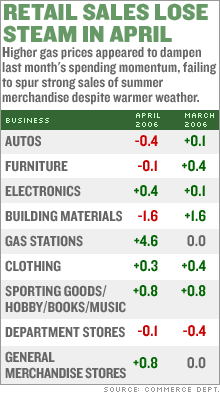|
Retail sales weaker than expected
Overall sales rose 0.5 percent in April, ex-auto sales rose 0.7 percent. Both numbers missed Wall Street forecasts.
NEW YORK (CNNMoney.com) - Retail sales at U.S. chain stores rose by a weaker-than-expected number last month, indicating that pain at the gas pump and rising interest rates may be starting to hit consumer spending. The Census Bureau Thursday reported a 0.5 percent increases in retail sales last month, compared with a 0.6 percent gain in March.
Economists surveyed by Briefing.com had forecast a 0.8 percent gain for the month. Retail industry analysts estimated that sales were probably strong going into April but started to lose momentum halfway through the month as consumers adjusted their shopping budgets to accommodate for the escalating price of gasoline. However, higher gas prices did boost sales at gasoline stations, gaining 4.6 percent last month and helped prop up overall retail sales. Without that gain, retail sales would have risen an anemic 0.1 percent. Excluding volatile auto sales, sales rose 0.7 percent for the month. Economists has forecast for a 0.9 percent gain. According to the report, car sales fell 0.4 percent in April versus a 1.0 percent gain in March. Furniture store sales fell 0.1 percent. Sales of building materials declined 1.6 percent while department stores logged a 0.1 percent decrease last month. But there were a handful of bright spots. Sales at sporting goods, music and book stores combined rose 0.8 percent in April, electronic sales increased 0.4 percent, and food and beverage sales rose 0.4 percent and clothing sales increased by 0.3 percent. Michael Niemira, chief economist and director of research with the International Council of Shopping Centers (ICSC), pointed to the weak building material sales as evidence that high energy prices weren't the only culprit that caused last month's damage. "Is the slowing spending in part because of gas? Yes but that is only part of the story. As interest rates rise, the housing market is slowing and we also seeing a negative savings rate," Niemira said. The Federal Reserve on Wednesday raised short-term rates by another quarter point to 5 percent -- its 16th straight increase in the past 22 months -- and indicated that it may need to keep raising rates depending on how the economy is doing. More increases in the Fed funds rate, which is an overnight bank lending rate, affects the rates consumers pay on credit cards, auto loans, home equity lines of credit and other types of debt. Low interest rates have made consumers feel wealthier as homeowners tapped into their home equity to bolster their discretionary incomes to offset energy costs. At the same time, some economists fear that if interest rates continue to creep higher and housing activity cools, that will start to put the brakes on retail spending, a worrisome scenario since consumer spending fuels two-third of the nation's economy. "From the Fed's perspective, maybe weaker sales number signal that it does not need to be as aggressive and raise rates at every meeting going forward," Niemira said. ----------------
For more news on the economy, click here. |
|

